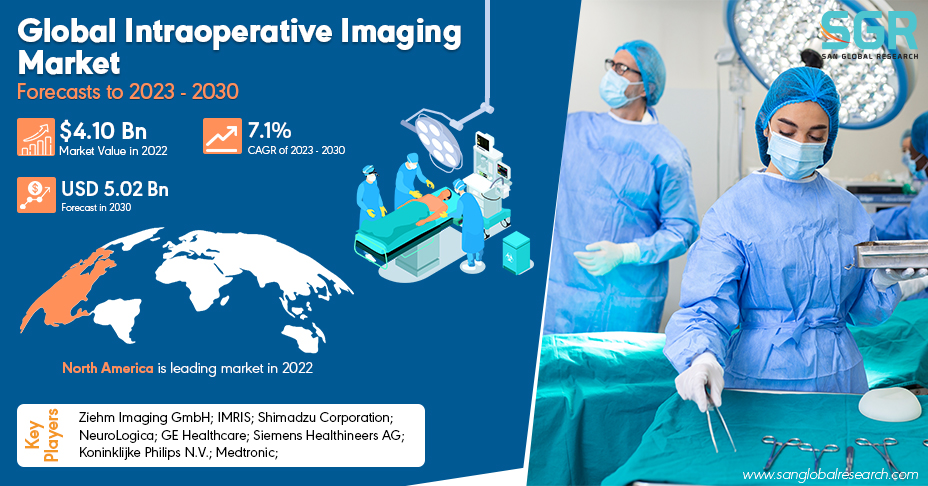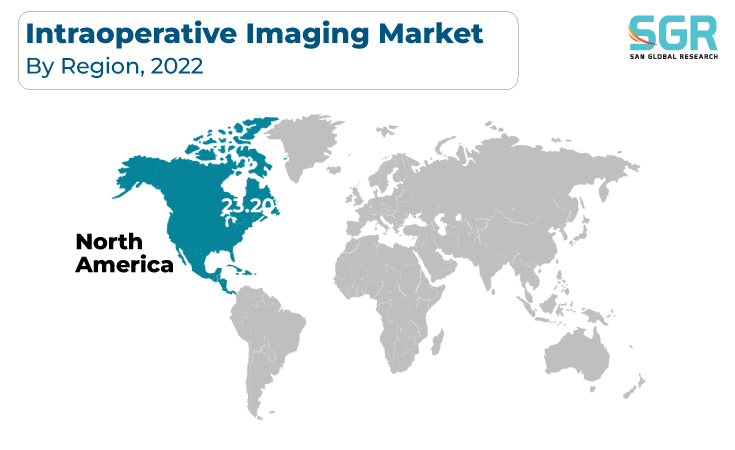Report Overview
The Intraoperative Imaging Market was valued at 4.10 Billion in 2022 and expected to grow at CAGR of 7.1% over forecast period.

Several critical factors drive the intraoperative imaging market. Advances in surgical techniques, as well as increased demand for minimally invasive procedures, have increased the demand for real-time imaging solutions during surgery. Intraoperative imaging technologies, such as mobile C-arms and intraoperative MRI/CT scanners, allow surgeons to see critical anatomical structures, guide interventions, and evaluate outcomes, improving surgical precision and patient safety. The growing prevalence of complex surgeries, as well as the rising adoption of image-guided interventions in orthopedics, neurology, and oncology, are also driving the market.
Furthermore, the desire to reduce repeat surgeries and post-operative complications fuels the demand for intraoperative imaging because it allows for immediate corrective actions. With continuous technological advancements improving image quality, speed, and accessibility, the intraoperative imaging market in the healthcare sector is poised for significant growth.
Type Outlook
Based on Type, the Intraoperative Imaging Market is segmented into C-arms, O-arms, and Others. C-arms segment accounted for largest share in 2022. The C-arms imaging market is driven by several key factors. The rise in the number of surgical and interventional procedures, coupled with the growing demand for real-time imaging guidance, fuels the adoption of C-arms in various medical specialties such as orthopedics, cardiology, and vascular surgery. The versatility of C-arm systems, which can be used in both surgical suites and interventional labs, enhances their appeal for diverse medical applications.
The increasing demand for advanced imaging solutions in orthopedic and spine surgeries, along with the rising prevalence of complex surgical cases, fuels the adoption of O-arms systems. These systems provide high-quality 2D and 3D images during surgery, enabling surgeons to accurately plan and execute procedures with improved precision. The O-arms' ability to offer real-time navigation and intraoperative assessment contributes to reduced complications and better patient outcomes.
Imaging Outlook
Based on Imaging, Intraoperative Imaging Market is segmented into 2-D and 3-D. Several critical factors drive the 2-D imaging market. The rising prevalence of medical conditions, as well as the growing demand for diagnostic procedures in a variety of medical specialties, drive the use of 2-D imaging modalities such as X-ray and ultrasound. These technologies provide valuable insights into anatomical structures, assisting in disease detection and diagnosis. Because of their versatility and low cost, 2-D imaging systems are suitable for a wide range of healthcare settings, including hospitals, clinics, and point-of-care facilities.
The growing demand for more comprehensive and detailed visualization in medical fields such as radiology, surgery, and dentistry is driving the adoption of 3-D imaging technologies such as CT scans, MRI, and 3-D ultrasound. These modalities offer improved insights into complex anatomical structures, allowing for more accurate diagnosis, treatment planning, and interventions. The growing trend toward personalized medicine and minimally invasive procedures fuels demand for 3-D imaging by allowing for precise patient-specific approaches.
Application Outlook
Based on Application, Intraoperative Imaging Market is segmented into neurosurgery, orthopaedic, ENT surgery, oncology, trauma surgery, cardiovascular, and others. The increasing prevalence of neurological disorders, coupled with the growing demand for precise and minimally invasive interventions in neurosurgical procedures, fuels the adoption of advanced imaging technologies such as intraoperative MRI, CT, and neuronavigation systems. These technologies provide neurosurgeons with real-time, high-resolution images that aid in accurate pre-operative planning and intraoperative guidance, leading to improved patient outcomes and reduced surgical risks. The rising emphasis on neuroimaging for early diagnosis and intervention further propels the demand for these imaging solutions. Additionally, ongoing technological innovations that enhance image quality, integrate surgical navigation, and enable image-guided therapies play a significant role in shaping the neurosurgery imaging market, catering to the complex needs of neurosurgical practice and research.
The increasing prevalence of musculoskeletal disorders, as well as the aging population, drive the demand for accurate and comprehensive imaging solutions in orthopedics. Advanced imaging technologies, such as X-ray, MRI, and CT, provide detailed insights into bone structure, joint health, and soft tissue conditions, allowing for more accurate diagnosis, treatment planning, and post-operative evaluations.
Regional Outlook
North America is emerged as leading market for Intraoperative Imaging Market in 2022. The region's well-established healthcare infrastructure, high prevalence of chronic diseases, and growing elderly population all contribute to increased demand for advanced imaging technologies across a wide range of medical disciplines. The emphasis on early diagnosis, personalized treatment approaches, and minimally invasive procedures drives the use of cutting-edge imaging modalities like MRI, CT, and PET/CT.
Asia Pacific is expected to be the second-most prominent area in terms of Intraoperative Imaging Market share. Rapid economic growth in the region, increased healthcare investments, and improved healthcare infrastructure all contribute to rising demand for advanced imaging technologies in a variety of medical specialties. The prevalence of chronic diseases and infectious illnesses increases the demand for accurate diagnostic tools like MRI, CT, and ultrasound, while the aging population emphasizes the importance of early detection and comprehensive imaging solutions.

Intraoperative Imaging Market Report Scope
| Report Attribute | Details |
| Market Value in 2022 | USD 4.10 Billion |
| Forecast in 2030 | USD 5.02 Billion |
| CAGR | CAGR of 7.1% from 2023 to 2030 |
| Base Year of forecast | 2022 |
| Historical | 2018-2021 |
| Units | Revenue in USD million and CAGR from 2023 to 2030 |
| Report Coverage | Revenue forecast, Industry outlook, competitive landscape, growth factors, and trends |
| Segments Scope | By Type, By Imaging, By Application |
| Regions Covered | North America, Europe, Asia Pacific, CSA and MEA |
| Key Companies profiled | Ziehm Imaging GmbH; IMRIS; Shimadzu Corporation; NeuroLogica; GE Healthcare; Siemens Healthineers AG; Koninklijke Philips N.V.; Medtronic; |
Global Intraoperative Imaging Market, Report Segmentation
Intraoperative Imaging Market, By Type
- C-arms
- O-arms
- Others
Intraoperative Imaging Market, By Imaging
- 2-D
- 3-D
Intraoperative Imaging Market, By Application
- Neurosurgery
- Orthopaedics
- ENT surgery
- Oncology
- Trauma surgery
- Cardiovascular
- Others
Intraoperative Imaging Market, Regional Outlook
North America
- U.S.
- Canada
- Mexico
Europe
- Germany
- UK
- Spain
- Russia
- France
- Italy
Asia Pacific
- China
- Japan
- India
- South Korea
- Australia
CSA
- Brazil
- Argentina
MEA
- UAE
- Saudi Arabia
- South Africa

 Description
Description
 Table of Content
Table of Content
 Gera Imperium Rise,
Gera Imperium Rise,  +91 9209275355
+91 9209275355


